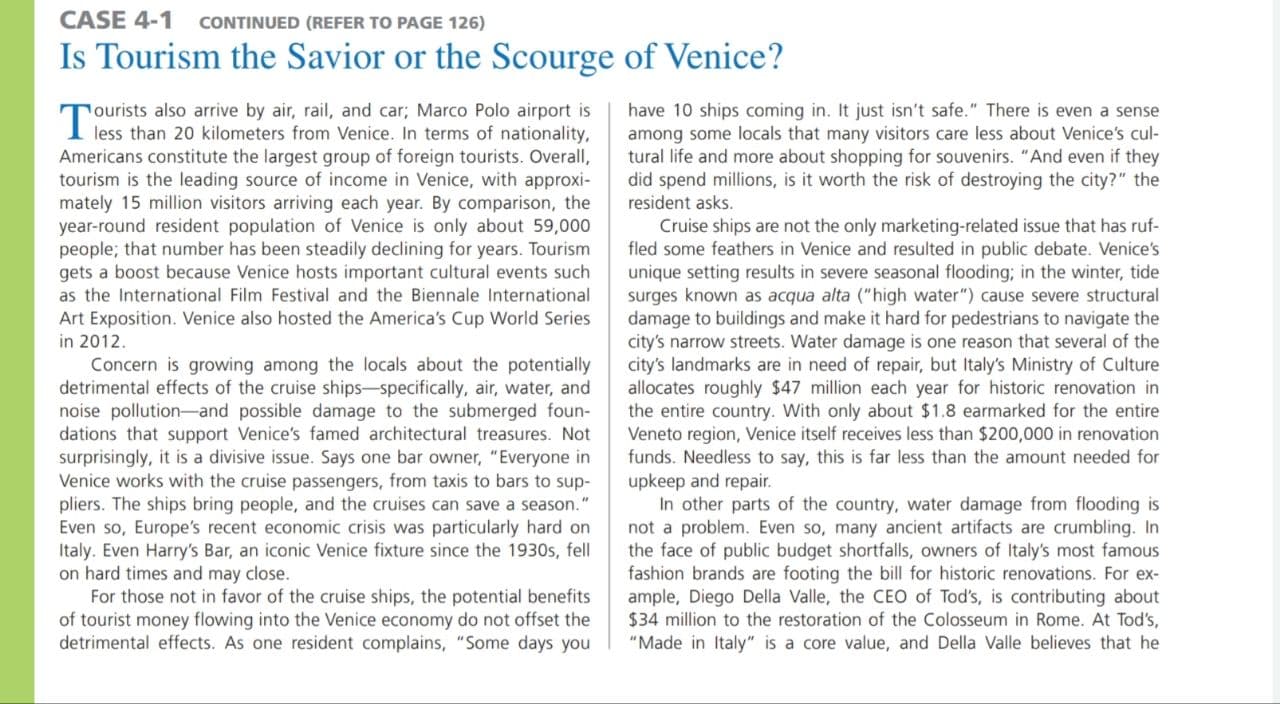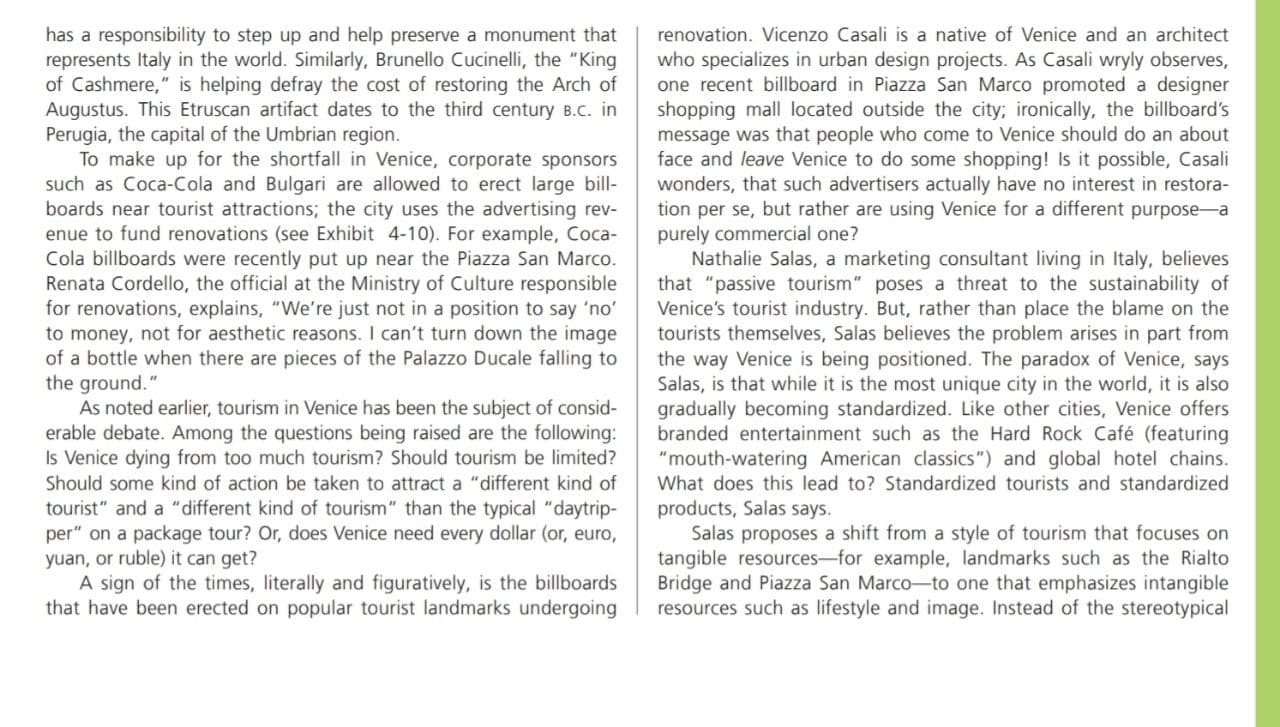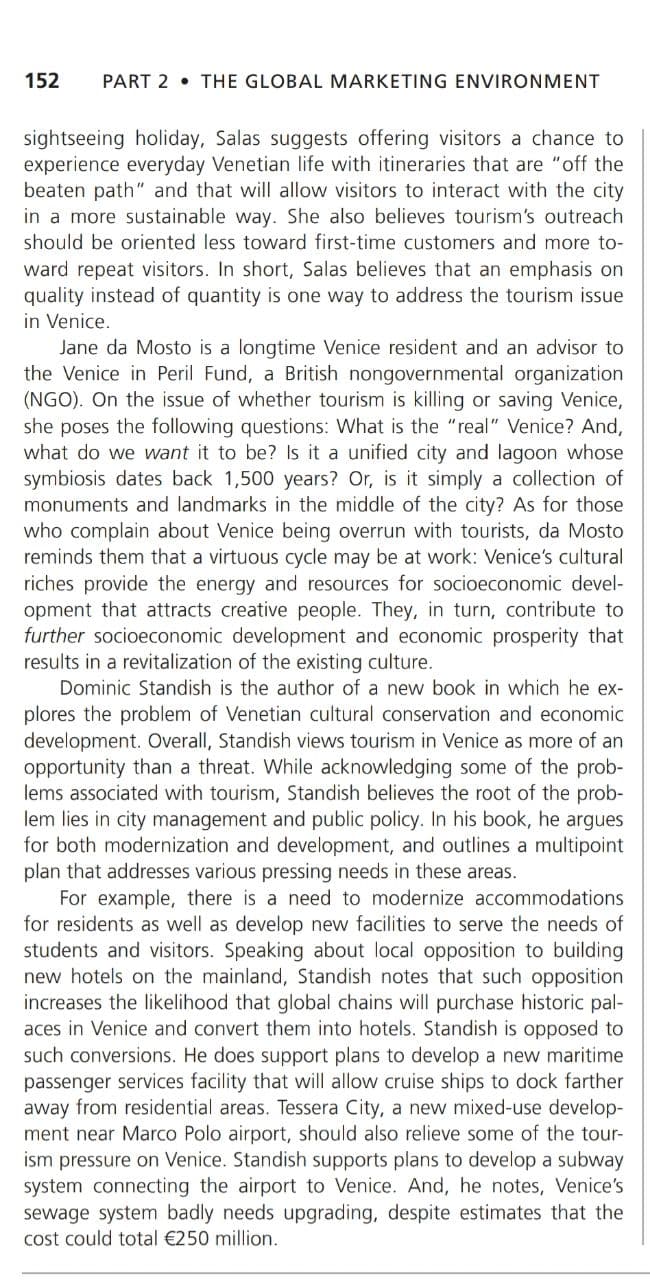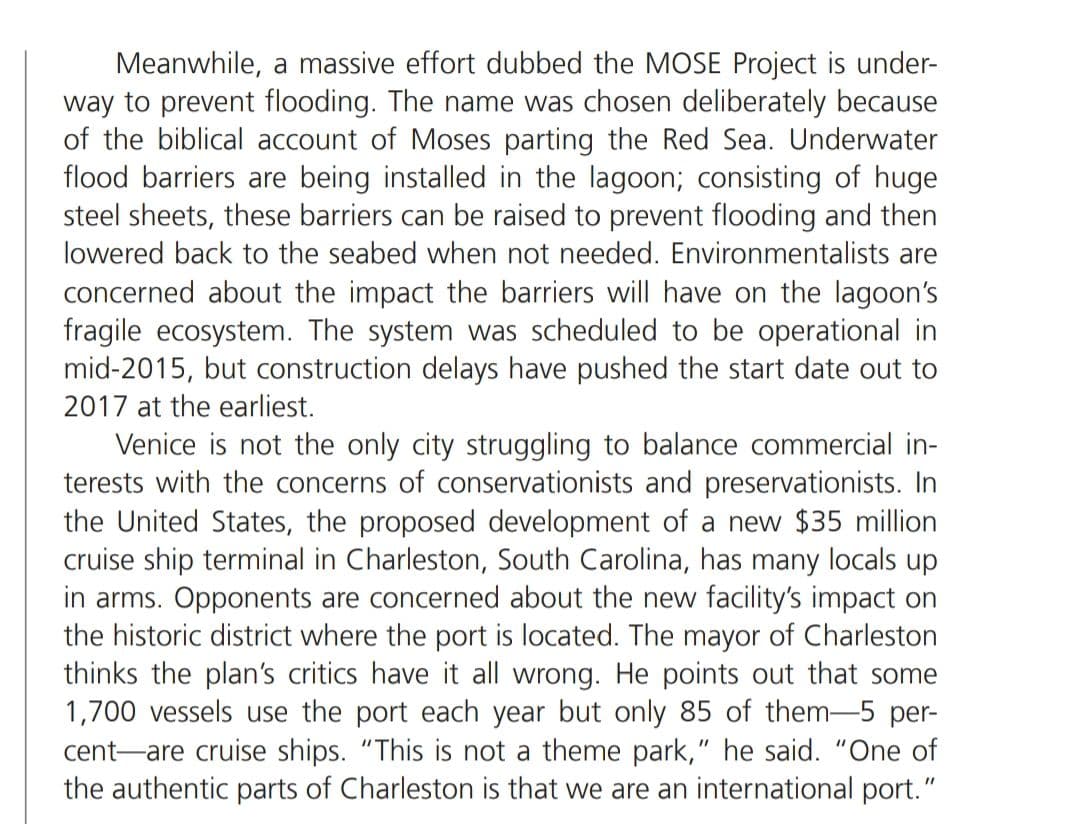Based on this picture, please answer this following question:
- The case presents various points of view on the issue of tourism in Venice. Whose perspective(s), if any, do you agree with?
- Should companies that contribute to historic renovation projects be allowed to place advertising on the buildings?
- In June 2011, city officials in Venice approved a tax on tourists staying in the city. Do you think this is a fair and effective way to generate revenue and limit the number of tourists?
If any student is found committing "plagiarism", he/she will be penalize
CASE 4-1 counuueo (REFER 1'0 PAGE 126} Is Tourism the Savior or the Scourge of Venice? ourists also arrive by air, rail. and car; Marco Polo airport is less than 20 kilometers from Venice. In terms of nationality. Americans constitute the largest group of foreign tourists. Overall, tourism is the leading source of income in Venice. with approxi' mately 15 million visitors arriving each year. By comparison. the year-round resident population of Venice is only about 59,000 people; that number has been steadily declining for years. Tourism gets a boost because Venice hosts important cultural events such as the International Film Festival and the Biennaie International Art Exposition. Venice also hosted the America's Cup World Series in 2012. Concern is growing among the locals about the potentially detrimental effects of the cruise shipsspecifically, air. water. and noise pollutionand possible damage to the submerged foun- dations that support Venice's famed architectural treasures. Not surprisingly. it is a divisive issue. Says one bar owner. \"Everyone in Venice works with the cruise passengens. from taxis to bars to sup- pliers. The ships bring people. and the cruises can save a season.\" Even so, Europe's recent economic crisis was particularly hard on Italy. Even Harry's Bar. an iconic Venice fixture since the 19305. fell on hard times and may close. For those not in favor of the cruise ships, the potential benefits of tourist money flowing into the Venice economy do not offset the detrimental effects. As one resident complains. \"Some days you have to ships coming in. It just isn't safe." There is even a sense among some locals that many visitors care less about Venice's cul- tural life and more about shopping for souvenirs. "And even if they did spend millions. is it worth the risk of destroying the city?" the resident asks. Cruise ships are not the only marketing-related issue that has ruf- fled some feathers in Venice and resulted in public debate. Venice's unique setting results in severe seasonal flooding; in the winter. tide surges known as acqua aita ("high water\") cause severe structural damage to buildings and make it hard for pedestrians to navigate the city's narrow streets. Water damage is one reason that several of the city's landmarks are in need of repair. but Italy's Ministry of Culture allocates roughly $47 million each year for historic renovation in the entire country. With only about $1.8 earmarked for the entire Veneto region. Venice itself receives less than $200,000 in renovation funds. Needless to say. this is far less than the amount needed for upkeep and repair. In other parts of the country. water damage from flooding is not a problem. Even so. many ancient artifacts are crumbling. In the face of public budget shortfalls, owners of Italy's most famous fashion brands are footing the bill for historic renovations. For ex- ample. Diego Della Valle. the CEO of Tod's. is centributing about $34 million to the restoration of the Colosseum in Rome. At Tod's. \"Made in Italy\" is a core value. and Della Valle believes that he Exhibit 4-10 Bulgari and other well- known luxury brands are funding the restoration, renovation, and mainte- nance of famous Venetian landmarks. In exchange for financial support, companies are allowed to place billboard advertising on buildings that are popular tourist destinations. Although the Venice Foundation considers such funding sources to be crucial, critics say that Renaissance landmarks should not be used for BULGARI commercial purposes. BULGARI Source: Marco Secchi/Getty Images. "H. CIELO DEI SOSPIRI"has a responsibility to step up and help preserve a monument that renovation. Vicenzo Casali is a native of Venice and an architect represents Italy in the world. Similarly, Brunello Cucinelli, the "King who specializes in urban design projects. As Casali wryly observes, of Cashmere," is helping defray the cost of restoring the Arch of one recent billboard in Piazza San Marco promoted a designer Augustus. This Etruscan artifact dates to the third century B.C. in shopping mall located outside the city; ironically, the billboard's Perugia, the capital of the Umbrian region. message was that people who come to Venice should do an about To make up for the shortfall in Venice, corporate sponsors face and leave Venice to do some shopping! Is it possible, Casali such as Coca-cola and Bulgari are allowed to erect large bill- wonders, that such advertisers actually have no interest in restora- boards near tourist attractions; the city uses the advertising rev- tion per se, but rather are using Venice for a different purpose-a enue to fund renovations (see Exhibit 4-10). For example, Coca- purely commercial one? Cola billboards were recently put up near the Piazza San Marco. Nathalie Salas, a marketing consultant living in Italy, believes Renata Cordello, the official at the Ministry of Culture responsible that "passive tourism" poses a threat to the sustainability of for renovations, explains, "We're just not in a position to say 'no' Venice's tourist industry. But, rather than place the blame on the to money, not for aesthetic reasons. I can't turn down the image tourists themselves, Salas believes the problem arises in part from of a bottle when there are pieces of the Palazzo Ducale falling to the way Venice is being positioned. The paradox of Venice, says the ground." Salas, is that while it is the most unique city in the world, it is also As noted earlier, tourism in Venice has been the subject of consid gradually becoming standardized. Like other cities, Venice offers erable debate. Among the questions being raised are the following: branded entertainment such as the Hard Rock Cafe (featuring Is Venice dying from too much tourism? Should tourism be limited? "mouth-watering American classics") and global hotel chains. Should some kind of action be taken to attract a "different kind of What does this lead to? Standardized tourists and standardized tourist" and a "different kind of tourism" than the typical "daytrip- products, Salas says. per" on a package tour? Or, does Venice need every dollar (or, euro, Salas proposes a shift from a style of tourism that focuses on yuan, or ruble) it can get? tangible resources-for example, landmarks such as the Rialto A sign of the times, literally and figuratively, is the billboards Bridge and Piazza San Marco-to one that emphasizes intangible that have been erected on popular tourist landmarks undergoing resources such as lifestyle and image. Instead of the stereotypical152 PART 2 0 THE GLOBAL MARKETING ENVIRONMENT sightseeing holiday, Salas suggests offering visitors a chance to experience everyday Venetian life with itineraries that are \"off the beaten path" and that will allow visitors to interact with the city in a more sustainable way. She also believes tourism's outreach should be oriented less toward first-time customers and more to- ward repeat visitors. in short, Salas believes that an emphasis on quality instead of quantity is one way to address the tourism issue in Venice. Jane da Mosto is a longtime Venice resident and an advisor to the Venice in Peril Fund, a British nongovernmental organization (N60). On the issue of whether tourism is killing or saving Venice, she poses the following questions: What is the \"real" Venice? And, what do we want it to be? Is it a unified city and lagoon whose symbiosis dates back 1,500 years? Or, is it simply a collection of monuments and landmarks in the middle of the city? As for those who complain about Venice being overrun with tourists, da Mosto reminds them that a virtuous cycle may be at work: Venice's cultural riches provide the energy and resources for socioeconomic devel- opment that attracts creative people. They, in tum, contribute to further socioeconomic deveiopment and economic prosperity that results in a revitalization of the existing culture. Dominic Standish is the author of a new book in which he ex- plores the problem of Venetian cultural conservation and economic development. Overall, Standish views tourism in Venice as more of an opportunity than a threat. While acknowledging some of the prob- lems associated with tourism, Standish beiieves the root of the prob- lem lies in city management and public policy. In his book, he argues for both modernization and development, and outlines a multipoint plan that addresses various pressing needs in these areas. For example, there is a need to modernize accommodations for residents as well as develop new facilities to serve the needs of students and visitors. Speaking about local opposition to building new hotels on the mainland, Standish notes that such opposition increases the likelihood that global chains will purchase historic pal- aces in Venice and convert them into hotels. Standish is opposed to such conversions. He does support plans to develop a new maritime passenger services facility that will allow cruise ships to dock farther away from residential areas. Tessera City, a new mixed-use develop- ment near Marco Polo airport, should also relieve some of the tour- ism pressure on Venice. Standish supports plans to develop a subway system connecting the airport to Venice. And, he notes, Venice's sewage system badly needs upgrading, despite estimates that the cost could total 250 million. Meanwhile, a massive effort dubbed the MOSE Project is under- way to prevent flooding. The name was chosen deliberately because of the biblical account of Moses parting the Red Sea. Underwater flood barriers are being installed in the lagoon; consisting of huge steel sheets, these barriers can be raised to prevent flooding and then lowered back to the seabed when not needed. Environmentalists are concerned about the impact the barriers will have on the lagoon's fragile ecosystem. The system was scheduled to be operational in mid-2015, but construction delays have pushed the start date out to 2017 at the earliest. Venice is not the only city struggling to balance commercial in- terests with the concerns of conservationists and preservationists. In the United States, the proposed development of a new $35 million cruise ship terminal in Charleston, South Carolina, has many locals up in arms. Opponents are concerned about the new facility's impact on the historic district where the port is located. The mayor of Charleston thinks the plan's critics have it all wrong. He points out that some 1,700 vessels use the port each year but only 85 of them5 per- centare cruise ships. \"This is not a theme park," he said. \"One of the authentic parts of Charleston is that we are an international port."











